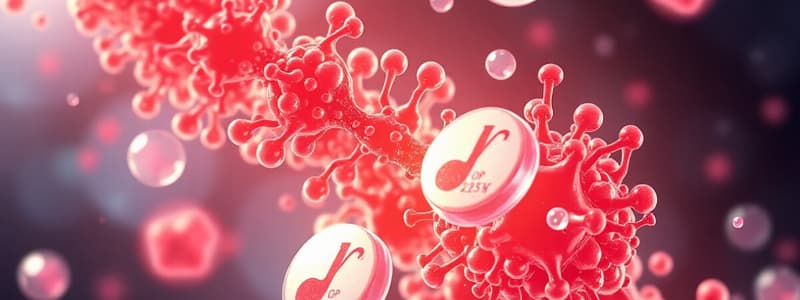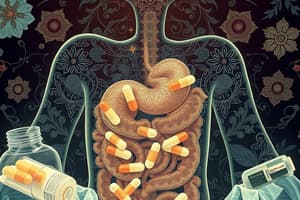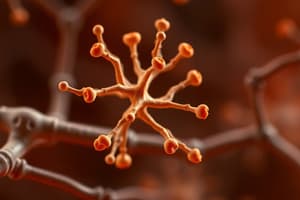Podcast
Questions and Answers
Which of the following best describes the primary mechanism of action of histamine H2 receptor antagonists?
Which of the following best describes the primary mechanism of action of histamine H2 receptor antagonists?
What is the effect of histamine H2 receptor antagonists on gastric acid secretion?
What is the effect of histamine H2 receptor antagonists on gastric acid secretion?
Which characteristic is a known limitation of histamine H2 receptor antagonists when compared to other acid-reducing medications?
Which characteristic is a known limitation of histamine H2 receptor antagonists when compared to other acid-reducing medications?
What is a typical bioavailability range for cimetidine when administered orally?
What is a typical bioavailability range for cimetidine when administered orally?
Signup and view all the answers
Which of the following best describes the elimination of histamine H2 receptor antagonist drugs and their metabolites?
Which of the following best describes the elimination of histamine H2 receptor antagonist drugs and their metabolites?
Signup and view all the answers
How does renal failure typically affect the half-life of histamine H2 receptor antagonist drugs?
How does renal failure typically affect the half-life of histamine H2 receptor antagonist drugs?
Signup and view all the answers
Which of the following is true regarding cimetidine's effects on drug metabolism?
Which of the following is true regarding cimetidine's effects on drug metabolism?
Signup and view all the answers
What is the primary mechanism of action for sucralfate?
What is the primary mechanism of action for sucralfate?
Signup and view all the answers
Which of the following histamine H2 antagonists has the least likely to inhibit the metabolism of other concurrently administered drugs?
Which of the following histamine H2 antagonists has the least likely to inhibit the metabolism of other concurrently administered drugs?
Signup and view all the answers
Which of the following is NOT a potential side effect of sucralfate?
Which of the following is NOT a potential side effect of sucralfate?
Signup and view all the answers
Under what condition should sucralfate be avoided?
Under what condition should sucralfate be avoided?
Signup and view all the answers
Which of these H2 antagonists has a high bioavailability and the least first pass effect?
Which of these H2 antagonists has a high bioavailability and the least first pass effect?
Signup and view all the answers
If a patient is taking warfarin and needs an H2 receptor antagonist, which one should be avoided?
If a patient is taking warfarin and needs an H2 receptor antagonist, which one should be avoided?
Signup and view all the answers
What is a significant drawback of quadruple therapy for Helicobacter pylori infection?
What is a significant drawback of quadruple therapy for Helicobacter pylori infection?
Signup and view all the answers
What drug class can interfere with the activity of sucralfate?
What drug class can interfere with the activity of sucralfate?
Signup and view all the answers
Why is sucralfate rarely used for the treatment of peptic ulcer disease (PUD)?
Why is sucralfate rarely used for the treatment of peptic ulcer disease (PUD)?
Signup and view all the answers
What is the primary mechanism of action of colloidal bismuth subcitrate?
What is the primary mechanism of action of colloidal bismuth subcitrate?
Signup and view all the answers
What is a key similarity between sucralfate and colloidal bismuth subcitrate?
What is a key similarity between sucralfate and colloidal bismuth subcitrate?
Signup and view all the answers
Which signaling molecule directly stimulates parietal cells to release gastric acid?
Which signaling molecule directly stimulates parietal cells to release gastric acid?
Signup and view all the answers
Which brain structure is NOT directly involved in the neural regulation of gastric acid secretion?
Which brain structure is NOT directly involved in the neural regulation of gastric acid secretion?
Signup and view all the answers
What is the primary function of antacids related to gastric acid?
What is the primary function of antacids related to gastric acid?
Signup and view all the answers
Which neurotransmitter primarily modulates the enteric nervous system's activity in gastric acid regulation?
Which neurotransmitter primarily modulates the enteric nervous system's activity in gastric acid regulation?
Signup and view all the answers
How does the anticipation of food affect gastric acid secretion?
How does the anticipation of food affect gastric acid secretion?
Signup and view all the answers
What is the role of PLC in the signaling cascade of gastric acid production?
What is the role of PLC in the signaling cascade of gastric acid production?
Signup and view all the answers
Which of the following signaling molecules inhibits gastric acid production?
Which of the following signaling molecules inhibits gastric acid production?
Signup and view all the answers
Which of the following is NOT a direct effect of acetylcholine in the release of HCl from parietal cells?
Which of the following is NOT a direct effect of acetylcholine in the release of HCl from parietal cells?
Signup and view all the answers
Which of the following brain areas is part of the brainstem and involved in the neural regulation of gastric acid release?
Which of the following brain areas is part of the brainstem and involved in the neural regulation of gastric acid release?
Signup and view all the answers
What is the clinical use of Potassium Competitive Acid Blockers?
What is the clinical use of Potassium Competitive Acid Blockers?
Signup and view all the answers
Which of the following is NOT a common side effect associated with high doses of Cimetidine?
Which of the following is NOT a common side effect associated with high doses of Cimetidine?
Signup and view all the answers
Which of the following histamine H2 receptor antagonists is LEAST likely to have antiandrogen effects?
Which of the following histamine H2 receptor antagonists is LEAST likely to have antiandrogen effects?
Signup and view all the answers
Which of the following conditions is LEAST effectively treated with histamine H2 receptor antagonists?
Which of the following conditions is LEAST effectively treated with histamine H2 receptor antagonists?
Signup and view all the answers
Which of the following is the S-enantiomer form of omeprazole?
Which of the following is the S-enantiomer form of omeprazole?
Signup and view all the answers
What is the primary mechanism by which proton pump inhibitors (PPIs) reduce gastric acid secretion?
What is the primary mechanism by which proton pump inhibitors (PPIs) reduce gastric acid secretion?
Signup and view all the answers
PPIs are considered prodrugs, which means that:
PPIs are considered prodrugs, which means that:
Signup and view all the answers
Why are PPIs considered to have a longer duration of action than their half-life would suggest?
Why are PPIs considered to have a longer duration of action than their half-life would suggest?
Signup and view all the answers
Where do proton pump inhibitors (PPIs) undergo the necessary conversion into active compounds?
Where do proton pump inhibitors (PPIs) undergo the necessary conversion into active compounds?
Signup and view all the answers
What is the effect of fasting on the efficacy of PPIs?
What is the effect of fasting on the efficacy of PPIs?
Signup and view all the answers
Compared to histamine H2 antagonists, how do Proton Pump Inhibitors differ in terms of onset of action and efficacy?
Compared to histamine H2 antagonists, how do Proton Pump Inhibitors differ in terms of onset of action and efficacy?
Signup and view all the answers
What role does H.Pylori play in increasing HCl acid levels in the stomach?
What role does H.Pylori play in increasing HCl acid levels in the stomach?
Signup and view all the answers
What is the primary reason why monotherapy with antibiotics is often ineffective in treating H.Pylori?
What is the primary reason why monotherapy with antibiotics is often ineffective in treating H.Pylori?
Signup and view all the answers
Which of the following therapies is considered the most effective for eradicating H.Pylori?
Which of the following therapies is considered the most effective for eradicating H.Pylori?
Signup and view all the answers
What is the effect of H.Pylori on somatostatin release from D cells?
What is the effect of H.Pylori on somatostatin release from D cells?
Signup and view all the answers
Which of the following statements about H.Pylori infection is false?
Which of the following statements about H.Pylori infection is false?
Signup and view all the answers
What effect do Proton Pump Inhibitors (PPIs) have on the absorption of itraconazole?
What effect do Proton Pump Inhibitors (PPIs) have on the absorption of itraconazole?
Signup and view all the answers
Which statement accurately describes the role of omeprazole in drug interactions?
Which statement accurately describes the role of omeprazole in drug interactions?
Signup and view all the answers
What is one significant advantage of PPIs over histamine H2 blockers?
What is one significant advantage of PPIs over histamine H2 blockers?
Signup and view all the answers
Potassium-Competitive Acid Blockers (P-CABs) are characterized by which of the following?
Potassium-Competitive Acid Blockers (P-CABs) are characterized by which of the following?
Signup and view all the answers
What is the initial action of P-CABs in relation to gastric acid secretion?
What is the initial action of P-CABs in relation to gastric acid secretion?
Signup and view all the answers
Which condition is commonly associated with H.Pylori infection?
Which condition is commonly associated with H.Pylori infection?
Signup and view all the answers
Which drug class provides better symptom relief in GERD compared to H2 blockers?
Which drug class provides better symptom relief in GERD compared to H2 blockers?
Signup and view all the answers
What is the mechanism by which H.Pylori attaches to gastric epithelial cells?
What is the mechanism by which H.Pylori attaches to gastric epithelial cells?
Signup and view all the answers
Study Notes
Peptic Ulcer Therapy
-
Lecture Objectives:
- Understand the diverse signaling systems for gastric acid production.
- Explain the development of peptic ulcer disease (PUD).
- Detail the mechanism of action and pharmacological differences among antacids.
- Define histamine H2 blockers, their pharmacology, and use in PUD.
- Discuss proton pump inhibitors and potassium competitive acid blockers, and their use in PUD.
- Discuss H. pylori-evoked gastric acid production and its eradication for PUD prevention.
- Detail the pharmacology of cytoprotective agents related to gastric acid production in PUD.
Receptors & Signals for Gastric Acid Production
- The presentation outlines the receptors and signaling pathways involved in gastric acid production.
- Key players include G cells, ECL cells, parietal cells, and vagus nerve.
- Various signaling pathways, like muscarinic, histamine, and gastrin, regulate gastric acid secretion.
- Drugs targeting these pathways, like antacids or H2 blockers, are described.
Role of CNS in Gastric Acid Release
- The Dorsal motor nucleus of the vagus (DMNV) in the brainstem is critical.
- Vagal efferent nerves releases acetylcholine affecting parietal cells to enhance HCl release.
- Sight, smell, taste, anticipate food trigger vagal nerve activity.
Antacids I
- Antacids are weak bases, neutralizing gastric acid.
- They are salts of Mg2+, Al3+, Ca2+, or bismuth.
- Sodium bicarbonate (NaHCO3) is very water-soluble and rapidly absorbed but its action is short-lived.
- Carbonates can lead to various side effects like belching, nausea, and diarrhoea.
- Calcium carbonate (CaCO3) is less soluble and can rapidly neutralize gastric HCI.
- It can cause hypercalcemia, milk-alkali syndrome, and acid rebound.
Antacids II
- Aluminum hydroxide (Amphojel) is insoluble, with a slow onset of action.
- Binds drugs like tetracyclines and phosphates, preventing their absorption.
- It can cause constipation due to relaxation of gastric smooth muscle.
- Magnesium hydroxide (Gelusil) is rapidly acting, but less absorbed than Sodium bicarbonate.
- This compound increases GIT motility and catharsis—resulting in a laxative effect.
- Al and Mg hydroxides (example: Maalox, Mylanta) can offset side effects like constipation/diarrhea.
- Alginates are polysaccharides to increase mucus viscosity.
- Simeticone relieves bloating and flatulence.
Antacids III
- Antacids neutralize gastric HCI and bind bile salts.
- They do not reduce HCl release, but can affect prostaglandin, mucus production, epithelial growth, lower esophageal sphincter pressure, and pepsin activity.
- Their main use is for indigestion, reflux esophagitis, and gastric/duodenal ulcers.
- Better drugs for PUD treatment are now available.
Antacids IV
- Frequent dosing, bad taste, and poor compliance are disadvantages.
- Al3+ and Ca2+ salts cause constipation, while Mg2+ salts cause diarrhoea.
- Milk-alkali syndrome is a severe condition from excess intake of NaHCO3 or CaCO3 with milk, causing metabolic alkalosis and potentially life-threatening hypercalcaemia.
- Acid rebound is a side effect of some antacids.
Antacids V
- Phosphate depletion and osteomalacia can result from aluminum salts.
- Al compounds precipitate phosphates, potentially useful for renal failure but not for chronic use.
- Hypernatremia and Mg toxicity are possible adverse effects, also with water retention, muscle weakness.
- Drug interactions like the change in pH altering bioavailability.
Histamine H2 Receptor Antagonists I
- Cimetidine, famotidine, nizatidine, and ranitidine are competitive reversible antagonists of histamine H2 receptors.
- They aim to reduce gastric acid secretion.
- They are frequently used in the treatment of PUD.
Histamine H2 Receptor Antagonists II
- The mechanism of action of histamine H2 receptor antagonists involves competitively inhibiting histamine H2 receptors.
- This leads to decreased gastric acid secretion.
- They are generally less effective than proton pump inhibitors.
Histamine H2 Receptor Antagonists III
- Effective absorption after oral intake, varying bioavailability among drugs.
- Short half-lives (1-3.5 hours) and durations of action (5-12 hours).
- Many H2 blockers should be taken at night to minimize night-time acid rebound.
- Limited metabolism with some drugs showing significant first-pass hepatic effects.
Histamine H2 Receptor Antagonists IV
- These drugs and their metabolites are excreted through the urine.
- Half-lives may increase in some patients with renal impairment
- This class of drugs can change acid production and pH to alter bioavailability of other drugs (e.g., aspirin, diazepam, warfarin, phenytoin).
Histamine H2 Receptor Antagonists V
- Overall, histamine H2 receptor antagonists are well tolerated.
- Potential CNS effects, endocrine effects (e.g., impotence, gynecomastia), gastrointestinal issues (e.g., diarrhea).
- Some blood disorders including thrombocytopenia and vitamin B12 deficiency can occur in some instances
Proton Pump Inhibitors I
- Omeprazole is the prototype, a racemic mixture of R- and S-isomers.
- Esomeprazole is the S-isomer.
- Lansoprazole is a racemic R and S mixture, has an R-enantiomer.
- Pantoprazole, and Rabeprazole are also available.
- Second-generation PPI include Rabeprazole, and Esomeprazole.
Proton Pump Inhibitors II
- PPI are prodrugs that are activated into active metabolites.
- Active metabolites bind to H+-K+ ATPase, which is the final step in HCl production.
- This effectively inhibits acid secretion.
Proton Pump Inhibitors III
- Rapid absorption, but variable depending on patient factors (e.g., fasting or presence of food).
- Bioavailability varies based on formulation.
- Dosage form and formulation are crucial as some need to be given before meals to prevent acid degradation.
- Extensive metabolism by the liver and often rapid hepatic first-pass metabolism is common.
Proton Pump Inhibitors IV
- Extensive metabolism in the liver, primarily by CYP2C19.
- Important consideration: patients with genetic polymorphism of CYP2C19 may have decreased enzyme activity leading to differences in efficacy and toxicity.
- Excretion mainly depends on hepatic metabolism followed by renal clearance. Renal failure patients may require lower levels of PPI.
Proton Pump Inhibitors V
- Adverse effects are mostly gastrointestinal, possibly including nausea, diarrhea, and constipation.
- Other potential effects include CNS issues, skin rash, liver enzyme impacts, and increased risk of interstitial nephritis.
- Decreased vitamin B12 absorption is also mentioned as a chronic therapy concern.
- Drug interactions are possible due to changes in gut pH.
Helicobacter Pylori Eradication I
- H. Pylori is a gram-negative rod.
- It lives in the acidic environment of the gastric lumen.
- It often infects individuals with or without symptoms.
- Eradication is necessary for some high-risk patients.
Helicobacter Pylori Eradication II
- Monotherapy with antibiotics is usually ineffective and can create resistance quickly.
- Combination therapy (at least two antibiotics) and acid suppression therapy is more effective.
- Triple therapy (PPI+amoxicillin+clarithromycin) or quadruple therapy are common approaches.
Cytoprotective Agents I
- Sucralfate is a coating agent that forms a viscous gel in the presence of acid, protecting the gastric mucosa.
- It is activated by acidic environments.
- It is used to treat PUD, with limited bioavailability.
- Not often used, replaced by more effective options like PPIs.
Cytoprotective Agents II
- Colloidal bismuth subcitrate (CBS) is a coating agent that protects the gastric mucosa through complex interaction with citric acid and bismuth.
- It does not exhibit substantial antacid properties.
- It is used to eradicate H. pylori.
- Side effects include black stools, darkening tongue, nausea, and diarrhoea, potentially resulting in bismuth poisoning with prolonged use.
Cytoprotective Agents III
- Misoprostol is a synthetic analog of PGE1 (prostaglandin).
- It can inhibit gastric acid secretion by impacting adenylate cyclase processes and stimulating different receptor types (e.g. EP3), especially in parietal cells.
- It is used to treat PUD and in situations of NSAID-induced ulcers and with pregnancy-associated issues
- Side effects can include abdominal cramps, diarrhea, uterine contractions (pregnancy contraindication) and inflammatory bowel disease exacerbation. Misoprostol is often less preferable and has been mostly replaced by alternative treatments.
Practice Questions
- Question 1: Pantoprazole is a proton pump inhibitor used in PUD treatment.
- Question 2: Calcium carbonate is likely to cause acid rebound.
Studying That Suits You
Use AI to generate personalized quizzes and flashcards to suit your learning preferences.
Related Documents
Description
This quiz covers essential aspects of histamine H2 receptor antagonists, including their mechanism of action, effects on gastric acid secretion, and limitations compared to other acid-reducing medications. Additionally, it explores the pharmacokinetics of drugs like cimetidine and sucralfate. Test your knowledge on these crucial pharmaceutical topics!




